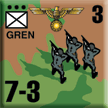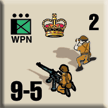| Beyond Normandy:
Publisher's Preview and Farewell
By Mike Bennighof, Ph.D.
May 2014
 Beyond Normandy is one of the handful of Panzer Grenadier games without our standard geomorphic maps. Instead it sports large paper maps of the area around the fateful Hill 112 in Normandy, with 44 scenarios set on them. Beyond Normandy is one of the handful of Panzer Grenadier games without our standard geomorphic maps. Instead it sports large paper maps of the area around the fateful Hill 112 in Normandy, with 44 scenarios set on them.
When I first designed the game system that became Panzer Grenadier, I knew I wanted to use geomorphic maps like other game systems did. These are small maps that represent more or less generic terrain, with several of them placed together to form the game map. That allows us to present many scenarios without including 50-odd separate maps in the game box.
In practice it turns out that a careful scenario designer can craft a pretty accurate situation using the generic maps, especially if he’s designed the “generic” maps to look like key pieces of terrain. I think we accomplished that really well in games like Elsenborn Ridge and Saipan 1944. But early on, I wasn’t sure how to do that, and also tried out the game system on “historical” maps based on “actual terrain.” I put those in scare quotes because transferring actual map data to a game map always involves some adjustments/fudging.
There aren’t a lot of locations that saw enough fighting during World War II to justify such a map, but Hill 112 is one of them. With Beyond Normandy, Brian Knipple crafted a very fine game centered on The Hill That Controlled Normandy. The scenarios flow together to create a campaign narrative, telling the story of the bloody battles for Hill 112 as the action progresses from one scenario to the next. Even 10 years after the game’s publication it’s still probably the best example of that in our lineup.
 The 44 scenarios cover the repeated British attempts to seize Hill 112, the German counter-attacks to push them back off it, and the battles that raged in the surrounding area. The British are pretty good, and usually have strong air and armor support and plentiful artillery including big naval guns. The Germans are usually tough veteran SS formations with the latest armor, plenty of firepower, good leadership and fanatic morale – these are the SS units of German propaganda, not the craven occupation troops that made up most Waffen SS formations. Unlike most of their brothers-in-arms, the SS men encountered in Beyond Normandy are actually willing to fight armed opponents. The 44 scenarios cover the repeated British attempts to seize Hill 112, the German counter-attacks to push them back off it, and the battles that raged in the surrounding area. The British are pretty good, and usually have strong air and armor support and plentiful artillery including big naval guns. The Germans are usually tough veteran SS formations with the latest armor, plenty of firepower, good leadership and fanatic morale – these are the SS units of German propaganda, not the craven occupation troops that made up most Waffen SS formations. Unlike most of their brothers-in-arms, the SS men encountered in Beyond Normandy are actually willing to fight armed opponents.
Beyond Normandy introduced a new concept to Panzer Grenadier that we did little to follow up on in subsequent games. British infantry battalions are separated by formation (four battalions’ worth of pieces are included, with their little unit “boxes” in the upper left colored white, red, green or blue to indicate their formation). It’s a simple method by which the British player can’t activate all of his troops at once, re-creating the command confusion that helped slow the British advance.
 With the British pouring in armor support and the Germans deploying their armored formations to stop them, there are plenty of tank battles to be fought. But this is not the open ground of the North African desert or Russian steppe; the fighting is channeled by the lines of hedgerows that divide the Norman countryside. Battles can be bloody and brutal, fought at very close ranges thanks to the hedgerows – thick agglomerations of the stones removed from the fields by fifty generations of farmers, held together by a dense network of living trees. With the British pouring in armor support and the Germans deploying their armored formations to stop them, there are plenty of tank battles to be fought. But this is not the open ground of the North African desert or Russian steppe; the fighting is channeled by the lines of hedgerows that divide the Norman countryside. Battles can be bloody and brutal, fought at very close ranges thanks to the hedgerows – thick agglomerations of the stones removed from the fields by fifty generations of farmers, held together by a dense network of living trees.
At the time it was new, Beyond Normandy marked a switch for Avalanche Press to overseas production, something I would come to deeply regret before the experiment ended a few years afterwards. All of its parts were originally printed in China, a process that took many weeks to complete followed by three or four months (yes, months) of shipping time. It was a very painful process and one I’m happy to never, ever repeat again: we now make everything in the United States.
 The Chinese-made game parts are for the most part of exceedingly high quality. The boxes are very sturdy; it’s become pretty much impossible to find American-made boxes quite like these. The maps are well-printed, on nice thick stock. They were folded improperly at the printer so they fit in the box kind of awkwardly, but fortunately they smooth out OK for play. The Chinese-made game parts are for the most part of exceedingly high quality. The boxes are very sturdy; it’s become pretty much impossible to find American-made boxes quite like these. The maps are well-printed, on nice thick stock. They were folded improperly at the printer so they fit in the box kind of awkwardly, but fortunately they smooth out OK for play.
The playing pieces, on the other hand, came to us from China with an interesting feature. They printed very nicely, and were put on the 48-point white core material we specified in the print order. And they’re cut pretty precisely as well.
 The problem comes with how they were cut: with the die-cutter set for enormous force, probably more than most machines in American plants could even handle (I’m guessing here, but based on a few decades’ experience on the publisher side of things it’s a pretty good guess). Die-cutting involves striking the pretty printed cardboard with tens of thousands of pounds of force to ram laser-cut steel blades through the material. This is why die-cutting leaves behind the signs of damage on the pieces. The problem comes with how they were cut: with the die-cutter set for enormous force, probably more than most machines in American plants could even handle (I’m guessing here, but based on a few decades’ experience on the publisher side of things it’s a pretty good guess). Die-cutting involves striking the pretty printed cardboard with tens of thousands of pounds of force to ram laser-cut steel blades through the material. This is why die-cutting leaves behind the signs of damage on the pieces.
Beyond Normandy’s pieces were struck so hard, they were flattened. Crushed to a thickness about 3/4 of the original material – something I didn’t even know was possible. By the time the production manager and I saw them over 1,000 copies of the game had been shipped from our warehouse, then located in Virginia hundreds of miles from world headquarters. They not bad pieces; the print quality, color match and die strike (how the die matches up with its target) are all outstanding. They just feel thinner than other Panzer Grenadier pieces (oddly, they don’t really look thinner but the difference is there when you pick them up).
 On those pretty pieces are some pretty powerful units; you can read about British infantry here, about British tanks here, and about the Waffen SS here. As an odd duck in the Panzer Grenadier line, Beyond Normandy never received the level of Daily Content support it really deserved. On those pretty pieces are some pretty powerful units; you can read about British infantry here, about British tanks here, and about the Waffen SS here. As an odd duck in the Panzer Grenadier line, Beyond Normandy never received the level of Daily Content support it really deserved.
Back in 2004 when we published Beyond Normandy, we had little to no brand management for any of our game lines. We published each item on its own, with no thought to how it should fit into the overall scheme (for there was no overall scheme). Now that such things are under firm control, it’s a lot more obvious in hindsight that Beyond Normandy could have been a far better product as a supplement to Liberation 1944, a game we didn’t release until a decade later.
 Right now we only seem to have a very small supply of counter sheet 3, and fairly large stocks of sheet 1 and 2 and the maps. There are not many boxes. My current plan is to retire Beyond Normandy when the supply of boxes and Sheet 3 runs out, whichever part goes first. We’ll keep the maps in storage and look to use them in the future in a supplement for Liberation 1944, but we have a lot of such parts on hand from the retirement of our comb-bound booklets so when the current supply runs out (and it’s well under 50 copies) this will be the end of Beyond Normandy for the foreseeable future. Right now we only seem to have a very small supply of counter sheet 3, and fairly large stocks of sheet 1 and 2 and the maps. There are not many boxes. My current plan is to retire Beyond Normandy when the supply of boxes and Sheet 3 runs out, whichever part goes first. We’ll keep the maps in storage and look to use them in the future in a supplement for Liberation 1944, but we have a lot of such parts on hand from the retirement of our comb-bound booklets so when the current supply runs out (and it’s well under 50 copies) this will be the end of Beyond Normandy for the foreseeable future.
Order Beyond Normandy while you still can!
Mike Bennighof is president of Avalanche Press and holds a doctorate in history from Emory University. A Fulbright Scholar and award-winning journalist, he has published over 100 books, games and articles on historical subjects.
He lives in Birmingham, Alabama with his wife, three children and his dog, Leopold.
|
